如何理性看待托福阅读机经
理清托福阅读结构很重要

智课网TOEFL备考资料理清托福阅读结构很重要摘要:理清托福阅读结构很重要,有多重要呢?如果你看一篇文章你练结构你都不知道你根本无法读懂他的意思,本文详细介绍阅读文章的重要性。
理清托福阅读结构很重要,我们有时会担心,阅读速度的加快会影响阅读理解的准确率,其实这是一种误解。
当然,盲目追求阅读速度必然要影响阅读理解的质量。
我们应该做的是掌握正确的阅读节奏:“根据快和慢两种速度交替而成的节奏来变化自己的阅读速度。
” 唱歌因韵律节奏而动听,说话因轻重缓急而悦耳,阅读也是一样,快慢相间的阅读速度才能收到良好的阅读效果。
我们知道,句子是由词组成的,但同一句中的各个词的分量不尽相同,有的起着关键的作用;段落是由句子构成的,然而同一段落中的各个句子的分量也是不尽相同的,有的是关键句、核心句,有的则起着辅助说明的作用,为阐述中心思想而服务。
这些关键词、关键句表达的正是段落的重要信息,抓住了它们就等于抓住了段落的核心,就知道了什么地方应该加快速度,什么地方应该放慢速度,当然也就掌握了阅读节奏。
一般而言,对于关键词和关键句应该慢读,做到充分理解,牢牢把握;而对非关键词和非关键句应加快阅读速度,抢出时间,用以反复阅读重点句或归纳总结。
请看下面的示例:例1:阅读下面的段落:A lot of people think that cultural anthropology is just about studying the special and strange aspects of a society, but anthropologists are also interested in the aspects of life that seems so ordinary that the people in the society think they are not significant.阅读此句,我们不难找到一些关键词,如:cultural anthropology, the special and strange aspects of life, but, anthropologists, interested, ordinary, significant。
托福3大用法注意事项提升机经实用价值

托福3大用法注意事项提升机经实用价值托福写作机经几乎每位考生都使用过,但总有同学反映机经价值不高虽然刷过但并没有多大提升,这其实与大家的机经使用方法有很大关系。
下面就和大家分享GRE写作怎样保证原创度,希望能够帮助到大家,来欣赏一下吧。
托福3大用法注意事项提升机经实用价值用好托福作文机经从端正心态开始我们在对待一份资料的使用的时候,要利用辩证的思维去看待问题。
对于托福写机经,里面的题目也都是真题,做为一个练习资料来说,是很有价值的。
但如果考生盲目地把机经当成救命稻草,把托福写作考试的成败全都寄托在机经上面的话,那么,其失败的可能性也会变得很大。
我们经常会听到这样一句话,机经不是雪中送碳,而仅仅是锦上添花,这句话说的非常有道理。
对于托福机经的使用,大家应该持有的态度就应该是把它当做真题来练习,而不要完全寄托于考试中看过的机经能够全部命中。
说到底,大家对于托福考试的态度也是有问题。
想想大家托福考试为的是什么?是为了之后在它国高等学府深造,给自己的学习和生活带来方便。
托福考试的定义也是对于英语能力的测试。
那么大家在备考托福考试的时候就应该从备考中提升自己的英语能力,而不仅仅是因为应付考试那么随意,因此,对于机经的使用也应该以提升自身实力为主要目标,而不是把通过托福考试拿到高分的希望全部寄托在机经之上。
如何发挥托福作文机经实用价值?在了解了托福写作机经的用法注意事项后,接下来就为大家简单介绍一下托福写作机经的正确使用方法,希望对大家托福备考有帮助。
1. 不能盲目迷信机经如上文所提到的,有些同学对托福机经的态度近乎盲目信任,这其实是有很大风险的。
它的风险就在于,考生太过于依赖机经,甚至觉得托福写作不用复习和准备了,只要找到一份机经命中率高的机经就可以了。
这种想法就太过极端了。
对托福写作机经来说,它最大的作用就是让我们能够提前了解可能出现的题目,提前构思一下作文的具体展开思路,再进一步也就是找找这个题目有没有范文适当参考学习一下。
托福机经正确使用切忌依赖机经
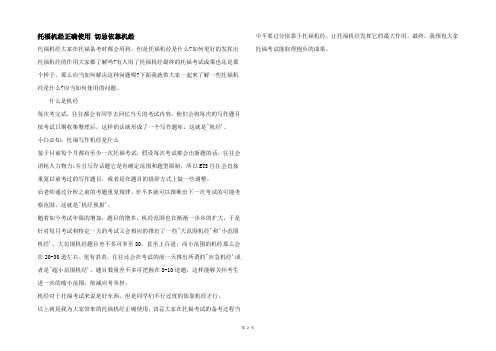
托福机经正确使用切忌依靠机经托福机经大家在托福备考时都会用到,但是托福机经是什么?如何更好的发挥出托福机经的作用大家都了解吗?有人用了托福机经最终的托福考试成果也还是那个样子,那么应当如何解决这种问题呢?下面我就带大家一起来了解一些托福机经是什么?应当如何使用的问题。
什么是机经每次考完试,往往都会有同学去回忆当天的考试内容。
他们会将每次的写作题目按考试日期收集整理后,这样的话就形成了一个写作题库,这就是"机经'。
小白必知:托福写作机经是什么鉴于目前每个月都有至少一次托福考试,假设每次考试都会出新题的话,往往会消耗人力物力;并且写作话题它是有确定范围和题型限制,所以ETS往往会直接重复以前考过的写作题目,或者是在题目的措辞方式上做一些调整。
而老师通过分析之前的考题重复规律,差不多就可以推断出下一次考试的可能考察范围,这就是"机经预报'。
随着如今考试年限的增加,题目的增多,机经范围也在渐渐一步步的扩大,于是针对每月考试和特定一天的考试又会相应的推出了一些"大范围机经'和"小范围机经'。
大范围机经题目差不多可多至80,甚至上百道,而小范围的机经那么会在20-30道左右。
更有甚者,往往还会在考试的前一天推出所谓的"应急机经'或者是"超小范围机经',题目数量差不多可把握在3-10道题,这样能够关怀考生进一步的缩小范围,削减应考负担。
机经对于托福考试来说是好东西,但是同学们不行过度的依靠机经才行。
以上就是我为大家带来的托福机经正确使用,切忌大家在托福考试的备考过程当中不要过分依靠于托福机经,让托福机经发挥它的最大作用。
最终,我预祝大家托福考试能取得抱负的成果。
第2页。
托福机经是什么?如何使用

托福机经是什么?如何使用关于托福独立写作部分,每期考试的机经,对于大家来说,也是比较好的复习内容。
有利于我们更好地提高具体的写作能力。
那么托福机经是什么?如何使用?一起来看看!托福机经是什么?如何使用问1:什么是机经?答1:“机经”是“机考经验”的简称,凡是考生对计算机考试内容的回忆,都可以叫做机经。
建议大家复习过程中不要盲目相信机经。
问2:机经与TPO有什么区别?答2:机经只是对考试的回忆,不是真正考试的原文和原题,信息缺失与失真频繁存在;TPO全称叫“TOEFL Practice On-line”(托福在线测试),是由ETS官方发布的真题,它曾经作为真正的托福考试题出现过。
问3:机经预测为什么能够实现?答3:将每次北美和大陆的托福考题记录,整理并编号,就会发现考题重复出现的规律,用该规律来预判未来考试的出题范围,就是机经预测。
问4:机经的编号方法和重复的基本规律是什么?答4:机经的编号是考试日期+考试地点,其中地点我们关注两个,一个是大陆,记为ML(Mainland),一个是北美,记为NA(North America)。
例如,20101030NA,表示的是2010年10月30日在北美发生的托福考试题。
基本的重复规律是:大陆会重复一段时间以前的北美的题目。
因此,对于大陆考生来说,利用北美的机经进行复习会比利用大陆机经复习更有意义。
问5:“新题”和“老题”指的是什么?答5:“新题”指的是该次考试的题目从来没有被考过,对于所有考生来说都是全新的,意味着不存在机经。
“老题”指的是该次考试已经在北美或者大陆(或者世界其他地区)出现过,有些考生之前已经考过该套题,这意味着我们能找到当次考试的机经。
问6:“新题”会比“老题”难吗?会影响学生的得分吗?答6:不会。
托福是标准化考试,考试难度不会因为新老题而发生改变;新老题也不会影响学生的成绩;能够影响学生成绩的,永远是学生的实力;能够影响学生实力的,是学生的勤奋。
4类机经正确使用方法 教你合理使用托福机经
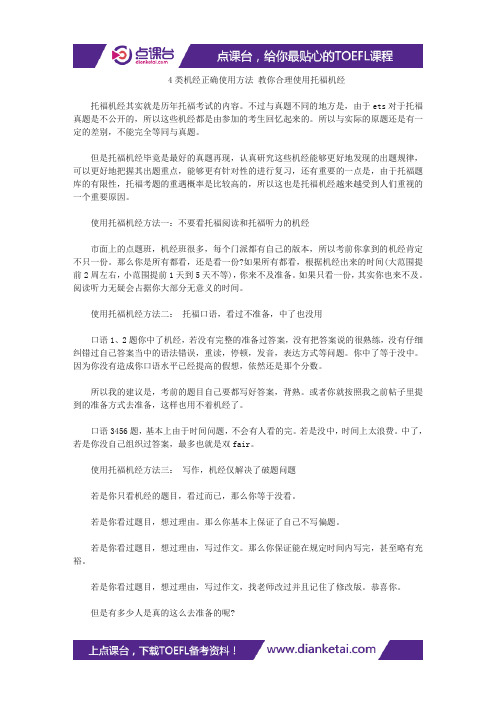
4类机经正确使用方法教你合理使用托福机经托福机经其实就是历年托福考试的内容。
不过与真题不同的地方是,由于ets对于托福真题是不公开的,所以这些机经都是由参加的考生回忆起来的。
所以与实际的原题还是有一定的差别,不能完全等同与真题。
但是托福机经毕竟是最好的真题再现,认真研究这些机经能够更好地发现的出题规律,可以更好地把握其出题重点,能够更有针对性的进行复习,还有重要的一点是,由于托福题库的有限性,托福考题的重遇概率是比较高的,所以这也是托福机经越来越受到人们重视的一个重要原因。
使用托福机经方法一:不要看托福阅读和托福听力的机经市面上的点题班,机经班很多,每个门派都有自己的版本,所以考前你拿到的机经肯定不只一份。
那么你是所有都看,还是看一份?如果所有都看,根据机经出来的时间(大范围提前2周左右,小范围提前1天到5天不等),你来不及准备。
如果只看一份,其实你也来不及。
阅读听力无疑会占据你大部分无意义的时间。
使用托福机经方法二:托福口语,看过不准备,中了也没用口语1、2题你中了机经,若没有完整的准备过答案,没有把答案说的很熟练,没有仔细纠错过自己答案当中的语法错误,重读,停顿,发音,表达方式等问题。
你中了等于没中。
因为你没有造成你口语水平已经提高的假想,依然还是那个分数。
所以我的建议是,考前的题目自己要都写好答案,背熟。
或者你就按照我之前帖子里提到的准备方式去准备,这样也用不着机经了。
口语3456题,基本上由于时间问题,不会有人看的完。
若是没中,时间上太浪费。
中了,若是你没自己组织过答案,最多也就是双fair。
使用托福机经方法三:写作,机经仅解决了破题问题若是你只看机经的题目,看过而已,那么你等于没看。
若是你看过题目,想过理由。
那么你基本上保证了自己不写偏题。
若是你看过题目,想过理由,写过作文。
那么你保证能在规定时间内写完,甚至略有充裕。
若是你看过题目,想过理由,写过作文,找老师改过并且记住了修改版。
恭喜你。
托福阅读机经使用方法和注意事项指点

托福阅读机经使用方法和注意事项指点托福阅读机经使用方法和留意事项教导, 学习文章思路重于背诵答案,今日我给大家带来了托福阅读机经使用方法和留意事项教导,盼望能够关心到大家,下面我就和大家共享,来观赏一下吧。
托福阅读机经使用方法和留意事项教导学习文章思路重于背诵答案托福阅读机经用法留意事项介绍托福阅读机经能够在考前阶段关心考生进行冲刺提分的预备,但考生能否用好阅读机经才是打算机经价值和学习效果的关键问题。
在使用托福阅读机经时,考生需要留意这几个问题:1. 托福阅读机经的文章怎么看?首先,托福阅读机经的文章部分是考生需要看的重点。
有的同学可能会觉得文章无所谓,看题目和答案才是首要目标,其实这种熟悉是错误的。
托福阅读考试的特点打算了其文章可能不会变,但题目可能会有很大变化,究竟只要有文章在,题目换个出题角度其实难度并不高。
也就是说,托福阅读考试是以文章为根本的。
所以考生刷阅读机经,重点首先要放在文章上。
那么文章究竟要怎么看呢?我认为大家对机经中文章的观看,关注点应当放在理解文章大意和结构框架上,文章里各个段落的一些细节内容大家没有必要去花太多心思理解甚至背诵,能够从整体上看懂文章在讲什么,段落和段落之间是以怎样的规律结构来关联起来的,了解了文章的整体脉络,大家才能更全面完整地理解这篇文章,之后无论托福怎样出题,考生都能在此基础上更为顺当的答题。
哪怕在考试中只是遇到了相同的文章而题目完全不同,考生应当也是能够较为轻松的应对的。
2. 托福阅读机经的题目怎么学?看完文章后,接下来大家要看的就是阅读的题目了。
虽然前面也说了题目的重要性不如文章,但我还是建议大家能够认真观看每道题目的出题方式,学习其中的出题思路。
时间精力允许的话最好自己动手把题目做一遍,无论对错都能积累肯定的实战阅历。
另外,看题目时切忌背诵答案。
哪道题目应当选哪个答案这种的信息其实完全不用去背,能够遇到完全一模一样的题目机会不大,假如题目改动过你还是根据原来背的挨次去选答案反而更简单出错扣分,原来凭自己实力能够做对的题目由于机经干扰反而做错了,岂不是特别惋惜?3. 托福阅读机经还要看什么?除了题目和答案外,托福阅读机经我还盼望大家在刷题过程中能够汇总收集一下其中的词汇,特殊是各类生词。
使用托福阅读机经正确操作

使用托福阅读机经正确操作相信大多数托福考生都知道机经这个东西,那么你们知道如何使用它才是正确的吗?跟随小编看看吧。
葛旭:托福阅读机经有什么用?在这个星球上做所有的事情都不易——尤其是那些能让自己真正感到自豪的事情。
如今跟托福结下孽缘的国人大多从上个世纪就开始痛下决心同英语死磕到底,结果不尽如人意、考后怨声载道哀鸿遍野的场面早已是常态。
我们有时太容易放弃,一遍遍履行“破罐子破摔”的谶语。
这样不好。
一种普遍的心态是:还有十天就上考场,再临阵磨枪夫复何用哉。
于是大家看到了点题班,仿佛看到了最后一棵救命稻草。
没错,我就想谈谈这临阵磨枪的“何用哉”部分,而且是谈一个曾经一度被认为不可能被点题的科目:阅读。
点题无非是寄希望于某一次考过的题目在即将来临的考试中再次出现,于是前人们含着悲愤眼泪回忆出来的东西便显得至关重要,这个东西叫“机经”。
我们有能力通过一定的规律来将下一次考试的范围缩小到一定程度,那么到这一步,能够呈献给大家只有一本写得乱七八糟前言不搭后语的机经组合。
现在问题出现了:几乎没有人能做到将阅读原文八九不离十地回忆出来,也几乎不会有人去刻意记忆那些错综复杂的阅读题型——实际上,机经的回忆者甚至不能保证自己在紧张激烈的阅读考试中是否真正读懂了文本与题目。
那么在机经上体现出来的就是一群杂乱无章的絮语。
那么通过阅读这些破碎而并不准确的汉语信息几乎解决不了实际问题。
我们需要的比这多。
那么我来告诉大家这阅读点题是如何剑走偏锋,达到某种“实用”之极致的。
那我就先介绍一个新的概念:叫做“关键词映射”。
阅读不会涉及校园生活,而是三篇最残暴的学术类文章。
每一篇文章都对应一个范围相对狭窄的话题,而每一个话题,实际都是由一个词或词组承载实意的。
这些词能够映射到其他相关联的、表示诠释或细化的词,到这里大家应该能意识到,它们就是文章的“关键词”。
不管机经回忆者的记忆有多么模糊,能够确定的一点就是,这些同我们生活并无太大关联的学术型关键词是几乎不可能被生造出来的——它们是机经里唯一值得我们信赖的东西。
备考看北美托福机经有没有用
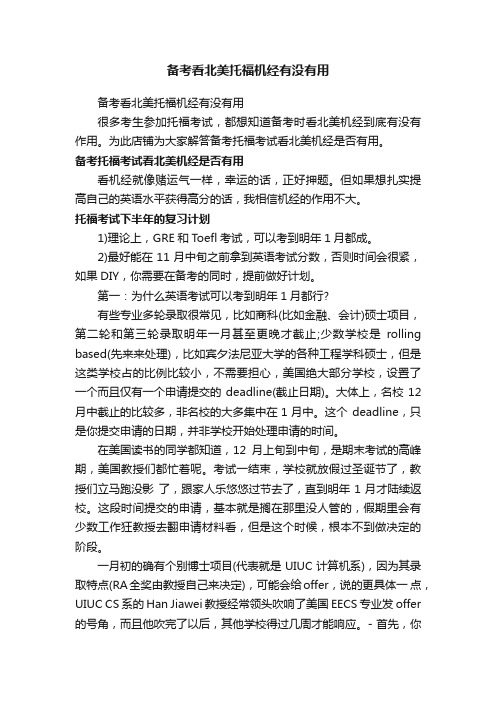
备考看北美托福机经有没有用备考看北美托福机经有没有用很多考生参加托福考试,都想知道备考时看北美机经到底有没有作用。
为此店铺为大家解答备考托福考试看北美机经是否有用。
备考托福考试看北美机经是否有用看机经就像赌运气一样,幸运的话,正好押题。
但如果想扎实提高自己的英语水平获得高分的话,我相信机经的作用不大。
托福考试下半年的复习计划1)理论上,GRE和T oefl考试,可以考到明年1月都成。
2)最好能在11月中旬之前拿到英语考试分数,否则时间会很紧,如果DIY,你需要在备考的同时,提前做好计划。
第一:为什么英语考试可以考到明年1月都行?有些专业多轮录取很常见,比如商科(比如金融、会计)硕士项目,第二轮和第三轮录取明年一月甚至更晚才截止;少数学校是rolling based(先来来处理),比如宾夕法尼亚大学的各种工程学科硕士,但是这类学校占的比例比较小,不需要担心,美国绝大部分学校,设置了一个而且仅有一个申请提交的deadline(截止日期)。
大体上,名校12月中截止的比较多,非名校的大多集中在1月中。
这个deadline,只是你提交申请的日期,并非学校开始处理申请的时间。
在美国读书的同学都知道,12月上旬到中旬,是期末考试的高峰期,美国教授们都忙着呢。
考试一结束,学校就放假过圣诞节了,教授们立马跑没影了,跟家人乐悠悠过节去了,直到明年1月才陆续返校。
这段时间提交的申请,基本就是搁在那里没人管的,假期里会有少数工作狂教授去翻申请材料看,但是这个时候,根本不到做决定的阶段。
一月初的确有个别博士项目(代表就是UIUC计算机系),因为其录取特点(RA全奖由教授自己来决定),可能会给offer,说的更具体一点,UIUC CS系的Han Jiawei教授经常领头吹响了美国EECS专业发offer 的号角,而且他吹完了以后,其他学校得过几周才能响应。
- 首先,你得申请计算机博士,其次,背景得很出色,否则,一月份UIUC的offer你也许不需要操心。
托福机经眼花缭乱,小站教育支招考前真题怎么用
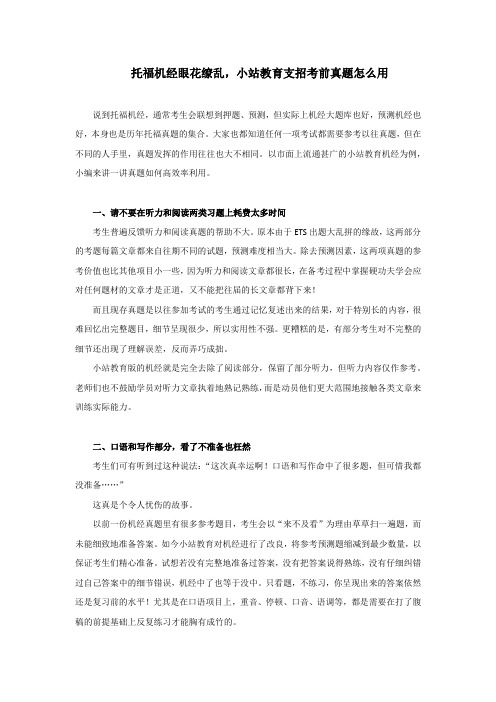
托福机经眼花缭乱,小站教育支招考前真题怎么用说到托福机经,通常考生会联想到押题、预测,但实际上机经大题库也好,预测机经也好,本身也是历年托福真题的集合。
大家也都知道任何一项考试都需要参考以往真题,但在不同的人手里,真题发挥的作用往往也大不相同。
以市面上流通甚广的小站教育机经为例,小编来讲一讲真题如何高效率利用。
一、请不要在听力和阅读两类习题上耗费太多时间考生普遍反馈听力和阅读真题的帮助不大。
原本由于ETS出题大乱拼的缘故,这两部分的考题每篇文章都来自往期不同的试题,预测难度相当大。
除去预测因素,这两项真题的参考价值也比其他项目小一些,因为听力和阅读文章都很长,在备考过程中掌握硬功夫学会应对任何题材的文章才是正道,又不能把往届的长文章都背下来!而且现存真题是以往参加考试的考生通过记忆复述出来的结果,对于特别长的内容,很难回忆出完整题目,细节呈现很少,所以实用性不强。
更糟糕的是,有部分考生对不完整的细节还出现了理解误差,反而弄巧成拙。
小站教育版的机经就是完全去除了阅读部分,保留了部分听力,但听力内容仅作参考。
老师们也不鼓励学员对听力文章执着地熟记熟练,而是动员他们更大范围地接触各类文章来训练实际能力。
二、口语和写作部分,看了不准备也枉然考生们可有听到过这种说法:“这次真幸运啊!口语和写作命中了很多题,但可惜我都没准备……”这真是个令人忧伤的故事。
以前一份机经真题里有很多参考题目,考生会以“来不及看”为理由草草扫一遍题,而未能细致地准备答案。
如今小站教育对机经进行了改良,将参考预测题缩减到最少数量,以保证考生们精心准备。
试想若没有完整地准备过答案,没有把答案说得熟练,没有仔细纠错过自己答案中的细节错误,机经中了也等于没中。
只看题,不练习,你呈现出来的答案依然还是复习前的水平!尤其是在口语项目上,重音、停顿、口音、语调等,都是需要在打了腹稿的前提基础上反复练习才能胸有成竹的。
三、根据复习时间的长短来分类处理世界上永远有两种考生:一种是计划周详,从很早开始就投入复习备考的;另一种的是永远寄希望于“临门一脚”,之前即使有过计划也被惰性和拖延症彻底毁掉的人。
浅析托福阅读技巧
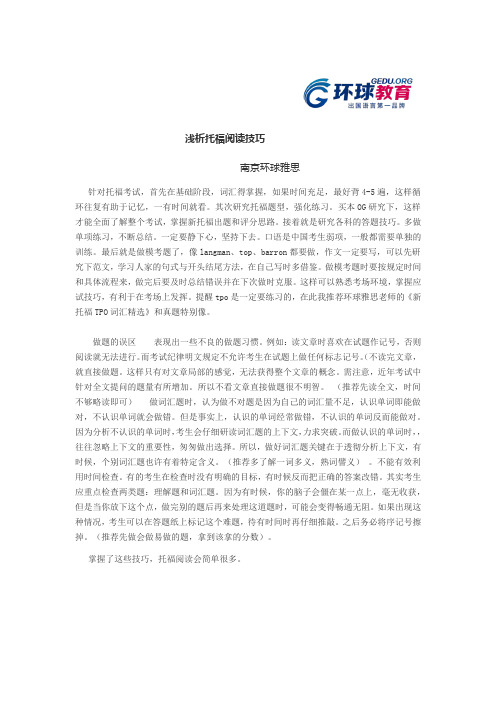
浅析托福阅读技巧南京环球雅思针对托福考试,首先在基础阶段,词汇得掌握,如果时间充足,最好背4-5遍,这样循环往复有助于记忆,一有时间就看。
其次研究托福题型,强化练习。
买本OG研究下,这样才能全面了解整个考试,掌握新托福出题和评分思路。
接着就是研究各科的答题技巧。
多做单项练习,不断总结。
一定要静下心,坚持下去。
口语是中国考生弱项,一般都需要单独的训练。
最后就是做模考题了,像langman、top、barron都要做,作文一定要写,可以先研究下范文,学习人家的句式与开头结尾方法,在自己写时多借鉴。
做模考题时要按规定时间和具体流程来,做完后要及时总结错误并在下次做时克服。
这样可以熟悉考场环境,掌握应试技巧,有利于在考场上发挥。
提醒tpo是一定要练习的,在此我推荐环球雅思老师的《新托福TPO词汇精选》和真题特别像。
做题的误区表现出一些不良的做题习惯。
例如:读文章时喜欢在试题作记号,否则阅读就无法进行。
而考试纪律明文规定不允许考生在试题上做任何标志记号。
(不读完文章,就直接做题。
这样只有对文章局部的感觉,无法获得整个文章的概念。
需注意,近年考试中针对全文提问的题量有所增加。
所以不看文章直接做题很不明智。
(推荐先读全文,时间不够略读即可)做词汇题时,认为做不对题是因为自己的词汇量不足,认识单词即能做对,不认识单词就会做错。
但是事实上,认识的单词经常做错,不认识的单词反而能做对。
因为分析不认识的单词时,考生会仔细研读词汇题的上下文,力求突破。
而做认识的单词时,,往往忽略上下文的重要性,匆匆做出选择。
所以,做好词汇题关键在于透彻分析上下文,有时候,个别词汇题也许有着特定含义。
(推荐多了解一词多义,熟词譬义)。
不能有效利用时间检查。
有的考生在检查时没有明确的目标,有时候反而把正确的答案改错。
其实考生应重点检查两类题:理解题和词汇题。
因为有时候,你的脑子会僵在某一点上,毫无收获,但是当你放下这个点,做完别的题后再来处理这道题时,可能会变得畅通无阻。
- 1、下载文档前请自行甄别文档内容的完整性,平台不提供额外的编辑、内容补充、找答案等附加服务。
- 2、"仅部分预览"的文档,不可在线预览部分如存在完整性等问题,可反馈申请退款(可完整预览的文档不适用该条件!)。
- 3、如文档侵犯您的权益,请联系客服反馈,我们会尽快为您处理(人工客服工作时间:9:00-18:30)。
如何理性看待托福阅读机经托福阅读备考中很多同学都会去网上找机经,不得不说,机经确实是备考环节非常重要的资料之一,但是大家不要盲目使用。
托福阅读机经如何正确使用呢?下面就和大家分享托福阅读机经怎么用,来欣赏一下吧。
托福阅读机经怎么用?理性看待机经一.托福阅读机经有多大价值?关于托福阅读机经价值这一点,如果大家找过比较多的机经就能发现一些端倪。
实际上很多****渠道不太靠谱的所谓真题机经都存在一些质量方面的问题。
这是因为很多托福阅读真题是靠考完试的同学回忆整理得来的,而这些回忆托福阅读真题的考生本身的水平就参差不齐,回忆的内容不完整或者出现疏漏甚至错误的情况比比皆是,他们给出的答案自然正确率也无法保证。
而即便是答案全对,在托福考试本身相当紧张的时间流程压力下,这些考生也难免会出现回忆中漏题或记错题等等问题,这就让这些托福阅读真题机经的准确性值得商榷了。
二.托福阅读机经不要背记答案除了考后回忆出的机经存在质量问题外,还有一点也让托福阅读真题机经的价值受到质疑,这就是所谓的变体题现象。
具体来说,ETS其实对于大家会在考后回忆整理真题的情况并非完全不知情,而其应对方法也非常简单,那就是更改题目,背过托福阅读真题的考生可能会发现,每次考试即便阅读*还是旧的*,但出现的题目却并不是完全一样的。
也就是说,ETS的托福阅读题库中,对于每一篇*并不是只有12-14道固定的题目。
因为每名考生在2次考试中遇到同一篇考试的概率不大,所以大家会觉得*都是重复的。
但其实每次的考题常会有所出入。
这些题目就是所谓的变体题。
特别是托福阅读真题中的词汇题、插入句子题、简化句子题等都是很容易进行改动的。
而哪怕是稍微复杂一些的细节题和要点总结题,选项也是可以很容易改变的。
三.不要太过依赖托福阅读机经很多考生对于托福阅读真题机经有着盲目的新人,觉得准备托福阅读时狂练真题就够了,认为背了真题考试时就可以万事大吉。
甚至有些同学的托福阅读备考方式就是背真题、看真题,把机经当成最有效的提分法宝。
这种过于极端的做法无疑是错误的。
托福考试考得不是记忆力而是语言能力,因此托福阅读真题机经能够带给大家的帮助其实也是有限的,是建立在考生本身具备足够的阅读能力才能体现出实际价值的。
因此,小站君建议大家在准备托福阅读时别太过于迷信机经,不要认为背了真题机经考试时问题就能迎刃而解,请从心态上就摆脱对托福阅读真题机经的依赖。
从2020年开始,托福考试每个考场会出现两套以上的不同考题,所以托福阅读考试的变数越来越大,即便是机经也很难准确预测。
大家一定要理性看待托福阅读机经,不要过分依赖机经。
打好基础,提高做题能力才是关键!托福阅读真题原题+题目There are only a few clues in the rock record about climate in the Proterozoic eon. Much of our information about climate in the more recent periods of geologic history comes from the fossil record, because we have a reasonably good understanding of the types of environment in which many fossil organisms flourished. The scarce fossils of the Proterozoic, mostly single-celled bacteria, provide little evidence in this regard. However, the rocks themselves do include the earliest evidence for glaciation, probably a global ice age.The inference that some types of sedimentary rocks are the result of glacial activity is based on the principle of uniformitarianism, which posits that natural processes now at work on and within the Earth operated in the same manner in the distant past. The deposits associated with present-day glaciers have been well studied, and some of their characteristics are quite distinctive. In 2.3-billion-year-old rocks in Canada near Lake Huron (dating fromthe early part of the Proterozoic age), there are thin laminae of fine-grained sediments that resemble varves, the annual layers of sediment deposited in glacial lakes. Typically, present-day varves show two-layered annual cycle, one layer corresponding to the rapid ice melting and sediment transport of the summer season, and the other, finer-grained, layer corresponding to slower winter deposition. Although it is not easy to discern such details in the Proterozoic examples, they are almost certainly glacial varves. These fine-grained, layered sediments even contain occasional large pebbles or dropstones, a characteristic feature of glacial environments where coarse material is sometimes carried on floating ice and dropped far from its source, into otherwise very fine grained sediment. Glacial sediments of about the same age as those in Canada have been found in other parts of North America and in Africa, India, and Europe. This indicates that the glaciation was global, and that for a period of time in the early Proterozoic the Earth was gripped in an ice age.Following the early Proterozoic glaciation, however, the climate appears to have been fairly benign for a very long time. There is no evidence for glaciation for the next 1.5 billion years or so. Then, suddenly, the rock record indicates a series of glacialepisodes between about 850 and 600 million year ago, near the end of the Proterozoic eon.1. Which of the following does the passage mainly discuss?(A) How patterns in rock layers have been used to construct theories about the climate of theProterozoic age(B) What some rare fossils indicate about glacial conditions during the late Proterozoic age(C) The varying characteristics of Proterozoic glacial varves in different parts of the world(D) The number of glacial episodes that the Earth has experienced since the Proterozoic age2. According to the passage , the fossil record of the Proterozoic eon is(A) highly regarded because it preserves the remains of many kinds of organisms(B) less informative than the fossil record of more recent periods。
